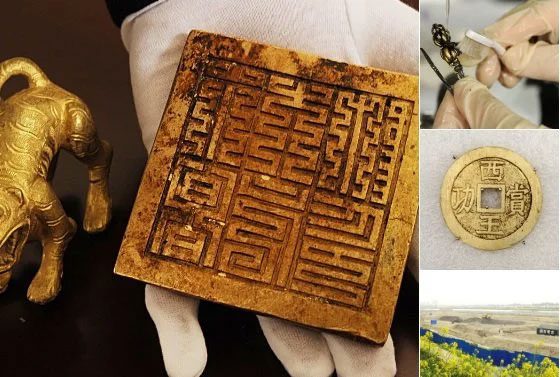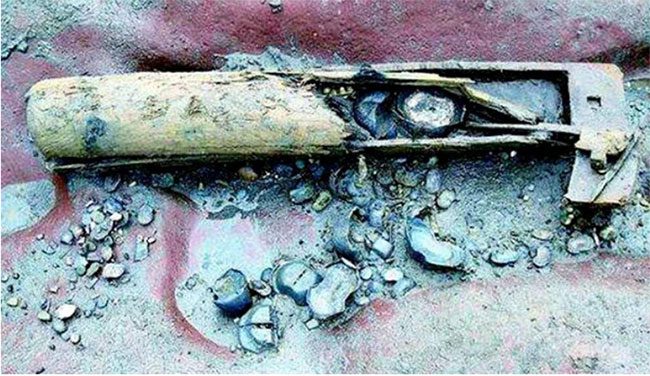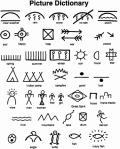According to archaeologists’ estimates, the treasure is valued at over 12 trillion VND.
On March 20, 2017, Chinese archaeologists announced the discovery of a treasure consisting of more than 10,000 gold and silver artifacts and jewelry dating back over 300 years, found at the bottom of a river in Sichuan Province, Southwest China.
The treasure was discovered at a depth of about 5 meters at the bottom of the river, approximately 50 kilometers south of the provincial capital, Chengdu.
The archaeologists visited the Min River for exploration, but due to the relatively strong river current, the excavation faced many difficulties. To ensure the excavation work could be carried out, a total of 20,000 square meters of dam was constructed, an unprecedented move in archaeological history. After the dam was built, 20 pumps began to continuously drain water, taking four months to remove all the water.

The treasure contains many gold jewelry pieces as well as iron weapons like swords and spears… (Illustrative image).
According to Gao Dalun, Director of the Institute of Archaeology and Cultural Heritage, the treasure includes many coins as well as gold, silver, and bronze jewelry, alongside iron weapons such as swords, knives, and spears. It took a total of five months to excavate the entire treasure from this large archaeological site. The value of the cultural relics they found has reached 500 million USD (over 12 trillion VND), which is a staggering figure.
It is currently unclear what characters are engraved on the gold and silver artifacts, but archaeologists have noted that the embossed designs on the jewelry demonstrate the skill and sophistication of artisans from ancient times.
Notably, an extremely rare pure gold seal was discovered. This seal weighs up to 8 kilograms and is made of 95% pure gold. The seal is intricately engraved with dimensions of 10 x 10 cm, featuring a handle made of pure gold shaped like a turtle, with the inscription “Treasure of the King of Shu”, unfortunately, it has been cut into four pieces.

A small part of the treasure. (Photo: Xinhua).
Among the artifacts found, scientists discovered a peculiar piece of wood about 1 meter long, which had a hollow section and was submerged in water, sand, and mud at a depth of 2.5 meters. Inside the wood were 10 silver ingots inscribed with the words: “In the 10th year of the Chongzhen era, facing the silver fifty-two, silver craftsman Kang Guokang.”
According to Wu Tianwen, Director of the Cultural Heritage Management Office of Pengshan, the piece of wood discovered is known as Qinggangbong. In various historical records, Qinggangbong was a tool used to hide treasures by Zhang Xianzhong – the leader of the peasant uprising at the end of the Ming Dynasty. This tool is a hollowed-out piece of wood with both ends sealed with iron, used to conceal silver ingots inside.

Qinggangbong hiding the silver ingots inside. (Photo: Sohu).
Additionally, the area where the artifacts were found is also where the peasant uprising leader Zhang Xianzhong was defeated by Ming soldiers in 1646.
Zhang Xianzhong was a peasant uprising leader during the late Ming Dynasty. He claimed the title of Great Western King after capturing Wuchang. According to the book “Shu Qiu Jian”, in 1644, Zhang Xianzhong led his troops into Sichuan, killing all the wealthy merchants there and seizing their assets. The amount of money he plundered from them reached tens of thousands of taels of gold. Zhang Xianzhong also organized a grand conference in Chengdu to flaunt his wealth. In many historical records, he had up to 24 rooms filled with gold and silver ingots.
Legend has it that before leaving Chengdu, Zhang Xianzhong hired a labor team to perform many odd tasks. He instructed them to build a dam on the Min River, drain the water, and dig many deep holes about 10 meters deep, then place all his treasures in them and cover them with earth to deceive the public. Zhang Xianzhong took 1,000 boats carrying the gold and silver treasures he had plundered to the Lao Hu port in Jiangkou, Pengshan County, but was unexpectedly ambushed by a Ming general, causing most of the fleet to sink in the river.
The Sichuan provincial government has plans to build a museum to preserve the artifacts near the excavation site.





















































